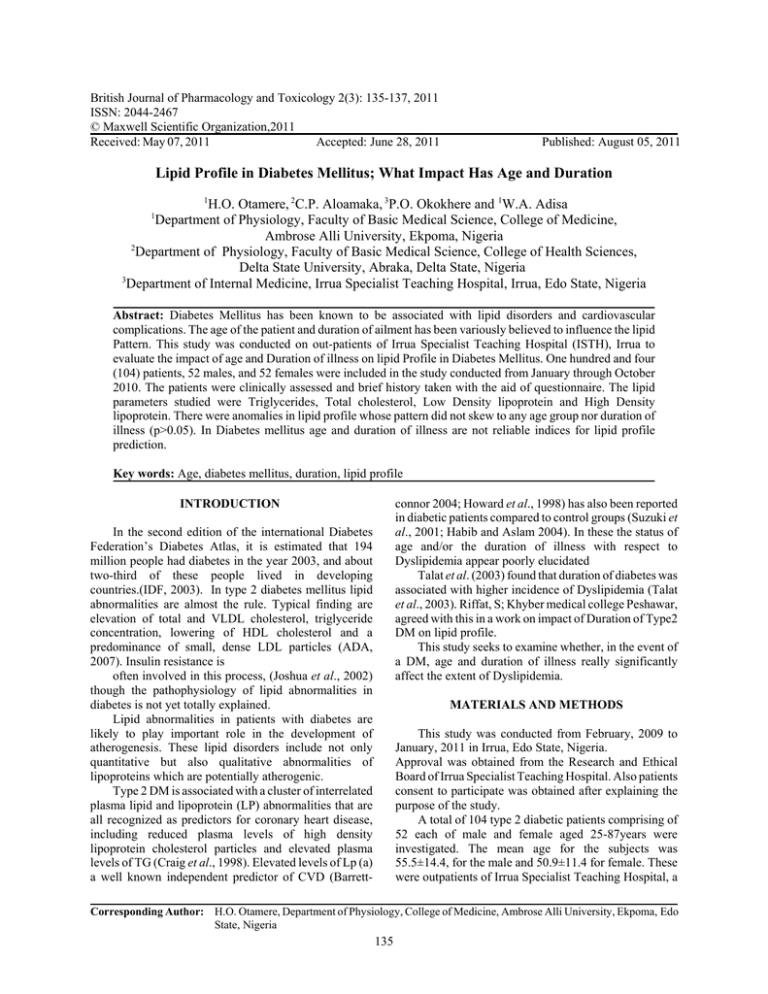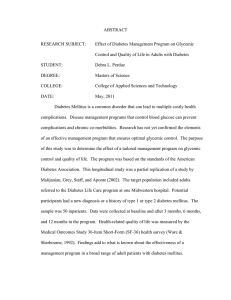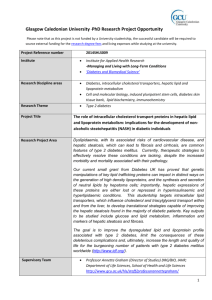British Journal of Pharmacology and Toxicology 2(3): 135-137, 2011 ISSN: 2044-2467
advertisement

British Journal of Pharmacology and Toxicology 2(3): 135-137, 2011 ISSN: 2044-2467 © Maxwell Scientific Organization,2011 Received: May 07, 2011 Accepted: June 28, 2011 Published: August 05, 2011 Lipid Profile in Diabetes Mellitus; What Impact Has Age and Duration 1 H.O. Otamere, 2C.P. Aloamaka, 3P.O. Okokhere and 1W.A. Adisa Department of Physiology, Faculty of Basic Medical Science, College of Medicine, Ambrose Alli University, Ekpoma, Nigeria 2 Department of Physiology, Faculty of Basic Medical Science, College of Health Sciences, Delta State University, Abraka, Delta State, Nigeria 3 Department of Internal Medicine, Irrua Specialist Teaching Hospital, Irrua, Edo State, Nigeria 1 Abstract: Diabetes Mellitus has been known to be associated with lipid disorders and cardiovascular complications. The age of the patient and duration of ailment has been variously believed to influence the lipid Pattern. This study was conducted on out-patients of Irrua Specialist Teaching Hospital (ISTH), Irrua to evaluate the impact of age and Duration of illness on lipid Profile in Diabetes Mellitus. One hundred and four (104) patients, 52 males, and 52 females were included in the study conducted from January through October 2010. The patients were clinically assessed and brief history taken with the aid of questionnaire. The lipid parameters studied were Triglycerides, Total cholesterol, Low Density lipoprotein and High Density lipoprotein. There were anomalies in lipid profile whose pattern did not skew to any age group nor duration of illness (p>0.05). In Diabetes mellitus age and duration of illness are not reliable indices for lipid profile prediction. Key words: Age, diabetes mellitus, duration, lipid profile connor 2004; Howard et al., 1998) has also been reported in diabetic patients compared to control groups (Suzuki et al., 2001; Habib and Aslam 2004). In these the status of age and/or the duration of illness with respect to Dyslipidemia appear poorly elucidated Talat et al. (2003) found that duration of diabetes was associated with higher incidence of Dyslipidemia (Talat et al., 2003). Riffat, S; Khyber medical college Peshawar, agreed with this in a work on impact of Duration of Type2 DM on lipid profile. This study seeks to examine whether, in the event of a DM, age and duration of illness really significantly affect the extent of Dyslipidemia. INTRODUCTION In the second edition of the international Diabetes Federation’s Diabetes Atlas, it is estimated that 194 million people had diabetes in the year 2003, and about two-third of these people lived in developing countries.(IDF, 2003). In type 2 diabetes mellitus lipid abnormalities are almost the rule. Typical finding are elevation of total and VLDL cholesterol, triglyceride concentration, lowering of HDL cholesterol and a predominance of small, dense LDL particles (ADA, 2007). Insulin resistance is often involved in this process, (Joshua et al., 2002) though the pathophysiology of lipid abnormalities in diabetes is not yet totally explained. Lipid abnormalities in patients with diabetes are likely to play important role in the development of atherogenesis. These lipid disorders include not only quantitative but also qualitative abnormalities of lipoproteins which are potentially atherogenic. Type 2 DM is associated with a cluster of interrelated plasma lipid and lipoprotein (LP) abnormalities that are all recognized as predictors for coronary heart disease, including reduced plasma levels of high density lipoprotein cholesterol particles and elevated plasma levels of TG (Craig et al., 1998). Elevated levels of Lp (a) a well known independent predictor of CVD (Barrett- MATERIALS AND METHODS This study was conducted from February, 2009 to January, 2011 in Irrua, Edo State, Nigeria. Approval was obtained from the Research and Ethical Board of Irrua Specialist Teaching Hospital. Also patients consent to participate was obtained after explaining the purpose of the study. A total of 104 type 2 diabetic patients comprising of 52 each of male and female aged 25-87years were investigated. The mean age for the subjects was 55.5±14.4, for the male and 50.9±11.4 for female. These were outpatients of Irrua Specialist Teaching Hospital, a Corresponding Author: H.O. Otamere, Department of Physiology, College of Medicine, Ambrose Alli University, Ekpoma, Edo State, Nigeria 135 Br. J. Pharmacol. Toxicol., 2(3): 135-137, 2011 RESULTS AND DISCUSSION tertiary health centre serving Ekpoma and surrounding communities Patients were on normal routine oral hypoglycemics, while those on insulin and lipid lowering drugs were excluded from the study. Pregnant women and those who could not observe a minimum of 10-12 h fast were also excluded. Table 1 shows the lipid profile of male and female Diabetics on the Basis of age group. The age groups comprises of young adult <40 years, middle aged 40-64 years, and elderly, $65 years. It was observed that the age group of subject did not have significant effect on the values of the respective lipids for both sexes (p>0.05) Table 2 shows the lipid profile of male and female Diabetics on the Basis of Duration of Diabetes. The duration comprises of <10 years, 10-20 years and >20 years. It was observed that the duration of diabetes did not have any significant effect on the values of the respective lipids for both sexes. (p>0.05) Many studies have shown altered lipid profile in diabetes mellitus, (Nakhjavani et al., 2006; Muna, 1993) and it has been further shown that the Dyslipidemia predisposes the diabetic patients to cardiovascular complications, especially the coronary heart disease (Barrett-connor, 2004; Kannel and Mcgee, 1979; Lee et al., 2000; Kanaya et al., 2002; Barrett-Connor and Wingard, 1983). In contrast to other studies, (Talat et al., 2003; Ochei and Kolhatkar, 2000) neither the age of the subjects nor the duration of the diabetes significantly affected the level of lipids P>0.05. In both tables the lipid parameters measured (TG, HDL, LDL and TC) fluctuated in such a distorted pattern among the various age group and duration of DM in both gender. It therefore appears impossible to delineate this into any neat formula for predicting lipid profile with respect to age group and/or duration of DM. This suggests that both variables (age of patient and duration of diabetes) may not be related to the severity of lipid disorder in diabetes mellitus. However, Ochei and Kolhatkar (2000) provided empirical Subjects classification: Subjects were divided into three groups each based on age and duration of illness. With respect to age are, age group <40, 40-64 and $65 years; while duration of illness include <10, 10 to 20 and >20 years as a diabetic. Questionnaire: For each subjects, information was obtained by the use of interviewer’s directly administered questionnaire. Data such as age, sex, duration of ailment, drugs, co-morbidity, smoking etc were obtained. Lipid profile study: Blood (4 mL) was obtained by venepuncture from all subjects using sterilized disposable syringes and needles. The lipid profile assay comprising of serum Triglycrides (TG), Total Cholesterol (TC), High Density Lipoprotein (HDL) cholesterol were done by the methods based on enzymatic determination using the kits purchased from Randox laboratories ltd. United Kingdom. Low Density Lipoprotein (LDL) was calculated from friedewald formula. Statistical analysis: The statistical analysis of data generated from this study was done by computer software Statistical Package for Social Sciences (SPSS). Values are expressed as a mean±standard error of the mean (SEM). The data is analyzed using Analysis of variance (ANOVA). p<0.05 is considered significant. Table 1: Lipid profile of diabetics on the basis of age Lipid Profile (mmol/dL) ------------------------------------------------------------------------------------------------------------------------------------------Age group (years) TG HDL LDL TC <40 Years (n = 9) male 2.57±0.69 3.30± 1.1 12.54±0.6 84.55±1.19 (n = 10) female 3.04±0.25 6.04±2.62 3.80±0.75 7.43±2.98 40-64Years (n = 29) male 2.36± 0.87 3.94± 1.06 3.42±0.36 5.95±1.46 (n = 36) female 2.30±0.52 3.45±0.47 3.78±0.50 7.22±1.46 $65 Years (n = 14) male 2.12± 0.68 4.52±1.12 3.13±1.08 5.18±1.49 (n = 6) female 1.70±0.41 2.51±0.94 5.15±1.10 8.70±1.10 ANOVA p>0.05 Table 2: Lipid profile of diabetics on the basis of duration of diabetes Diabetic duration TG (mmol/L) HDL (mmol/L) <10 yrs (21) male 2.68±0.59 3.63±1.01 <10 yrs (29) female 1.94±0.67 3.41±1.41 10-20 yrs (17) male 2-98±1.11 4.75±1.64 10-20 yrs (15) female 2.02±1.07 3.76±1.17 >20 yrs (14) male 2.07±0.36 2.90±0.92 >20 yrs (8)f emale 4.37±1.42 4.88±0.21 ANOVA p>0.05 136 LDL (mmol/L) 3.48±0.98 3.19±1.94 2.99±1.11 4.741.63 2.99±1.88 3.28±0.64 TC (mmol/L) 6.42±2.11 3.45±0.62 4.57±1.68 2.5±3.14 5.30±1.17 5.52±1.24 Br. J. Pharmacol. Toxicol., 2(3): 135-137, 2011 evidence indicating that lipids and cholesterol levels increase with age. Also, there are reports (Schwart et al., 1992; Ramirez et al., 1992; Bucala et al., 1993; Lyons et al., 1993) indicating that there is alteration in vascular functional integrity in diabetes mellitus, and that the alteration is dependent on the duration of the condition. Age has also been said to contribute to elevated lipid parameters (Estari et al., 2000) but Nakhjavani et al. (2006) reported that there is no correlation between diabetes mellitus and the alteration in the pattern of lipid profile. It is equally important to note that the diabetic subjects were on medications (oral hypoglycemics). Such treatment reduces the blood glucose level and most probably alters the overall pathophysiology, including the lipidemia of the condition. Overall diabetes mellitus is closely associated with Dyslipidemia but age group and DM duration may not be strong indices for lipid profile prediction especially with respect to subjects under management. Howard, B.V., L.D. Cowan, O. Go, T.K. Welty, D.C. Robbins and E.T. Lee, 1998. Adverse effects of diabetes on multiple cardiovascular disease risk factors in women. The strong heart study. Diabetic Care, 21(8): 1258-1265. International Diabetes Federation (IDF), 2003. Access to Insulin: A Report on the IDF Insulin Task Force on Insulin. 1994-1997. Joshua, A., B. Becham and P. Libby, 2002. Diabetes and atherosclerosis. JAMA, 287: 2570-2581. Kanaya, A., D. Grady and E. Barret-Connor, 2002. Explaining the sex difference in coonary heart disease mortality among patients with type 2 diabetes Mellitus: A meta analysis. Arch. Interm. Med., 162(15): 1737-1745. Kannel, W.B. and D.L. McGee, 1979. Diabetes and cardiovascular disease. The framingham study. JAMA, 241(19): 2035-2038. Lee, W.L., A.M. Cheung, D. Cape and B. Zinman, 2000. Impact of diabetes on coronary artery disease in women and men and men: A meta-analysis of prospective studies. Diabetes Care, 23(7): 962-968. Lyons, T.J., M.F. Lopez-Virella and J.W. Baystle, 1993. Glycation, oxidation and glyoxidation in the pathogenesis of atherosclerosis in diabetes. Modern Med., 61(suppl 2): 4-8. Muna, W.F., 1993. Cardiovascular disorders in Africa. World Health Stat Q., 46: 125-133. Nakhjavani, M., A.R. Esteghamati, F. Esfahanian and A.R. Heshmat, 2006. Dyslipidemia in type 2 Diabetes mellitus: More athergnenic lipid profile in women. Acta Med. Iranica, 44(2): 111-118. Ochei, J. and Kolhatkar, 2000. A Medical Laboratory Sciences Theory and Practice. Tata M. Graw-Hill, pp: 188-198. Ramirez, L.C., C. Arauz-Pacheco, C. Laxkner, G. Albrigh, B.V. Adams and P. Raskin, 1992. Lipoprotein (a) levels in diabetes mellitus: Relationship to metabolic control. Ann. Intern. Med., 117: 42-47. Schwart, C.J., A.J. Valente, E.A. Spargue, J.L. Kelly, A.J. Cayatte and M. Rozels, 1992. Pathogenesis of the atherosclerotic lesion: Implication for diabetes mellitus. Diabetes Care,15: 1156-1167 Suzuki, T., K. Oba, Y. Igari, N. Matsumua, Y. Inuzuka, Y. Kigawa, Y. Ajiro, K. Okazaki, H. Nakano and S. Metori, 2001. A four-year prospective study on the influence of serum elevated lipoprotein (a) concentration on ischemic heart disease and cerebral infarction in elderly patients with type 2 diabetes. Nippon Ronen Igakkai Zasshi, 38(4): 507-513. Talat, N., K. Amir, M. Gulsena and B. Bilal, 2003. Dyslipidemias in type 2 diabetes mellitus patients in a teaching hospital of Lahore, Pakistan. Pak. J. Med. Sci., 19: 283-286. ACKNOWLEDGMENT The authors wish to acknowledge the technical support of Mrs. Adesuwa Edeingbe and Mr. A.A. Akhile. REFERENCES American Diabetes Association (ADA), 2007. Standards of medical care in diabetes. Diabetes Care, 30: 4-41. Barrett-Connor, E., E.G. Giardian, A.K. Gitt, U. Gudat, H.O. Steinberg and D. Tscheope, 2004. Women and heart disease; The role of diabetes and hyperglycemia. Arch. Intern. Med., 164(9): 9344-942. Barrett -Connor, E. and D.L. Wingard, 1983. Sex differential in ischemic heart disease mortality in diabetics: a prospective population-based study. Am. J. Epidemiol., 118(4): 489-496. Bucala, R., Z. Makita, T. Kos Hinsky, A. Cerami and H. Vlassara, 1993. Lipid advanced glycosyltion: pathway for lipid oxidation in vivo. Proc. Natl. Acad. Sci. USA, 90: 6434-6438. Craig, W.Y., L.M. Neveux, G.E. Palomaki, M.M. Cleveland and J.E. Hadow, 1998. Lipoprotein (a) as a risk factor for ischemic heart disease: Metaanalysis of prospective studies. Clin Chem., 44(11): 2301-2306. Estari, M., A.S. Reddy, T. Bikshapathi, J. Satynanarayana, L. Venkanna, T.J. Aspray and K.G. Alberti, 2000. Hypertension prevalence and care in an urban and rural area of Tazania. J. Hypertens., 18(2): 145-52. Habib, S.S. and M. Aslam, 2004. Lipids and lipoprotein (a) concentration in Pakistani patients with Type 2 diabetes Mellitus. Diabetes Obes. Meta, 6(5): 338-343. 137




